A group of construction officials of the Union Pacific Railroad at their headquarters in Laramie in 1867.
Click here to learn more about the history of the Union Pacific Railroad.
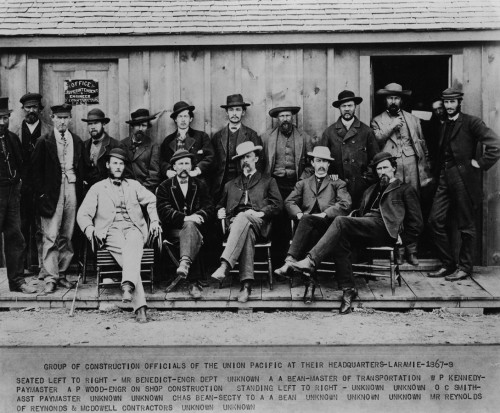
A group of construction officials of the Union Pacific Railroad at their headquarters in Laramie in 1867.
Click here to learn more about the history of the Union Pacific Railroad.
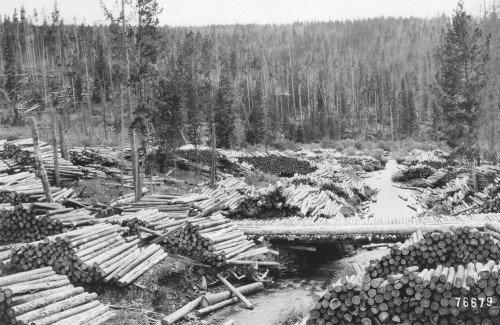
Building the railroad required a constant supply of timber to build railroad ties. The ties were cut from timber in the mountains surrounding Laramie, including the logs in this photograph, which were cut down in the Medicine Bow Mountains southwest of Laramie.
The ties were milled in the mountains, floated down the rivers to a Union Pacific Railroad location and finally transported to the end of the line to be used in the track.
Learn more about the building of the Transcontinental Railroad.
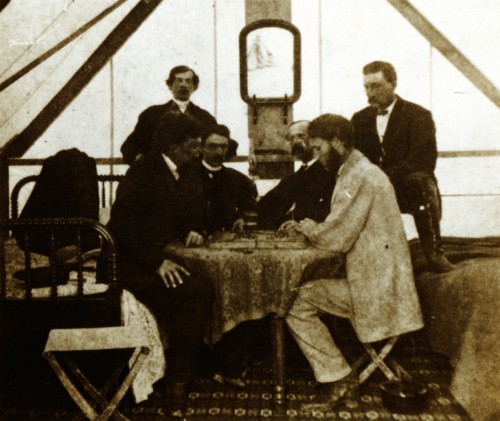
The railroad laborers visited the paymaster every week. The paymaster was in charge of paying the men their wages and keeping track of which men were assigned which jobs.
Protection was necessary in order to guard the paymaster and ward off any potential thieves. On the other hand, crooked paymasters often took advantage of the immigrant workers who did not know the U. S. dollar system.
Learn more about the building of the Transcontinental Railroad.
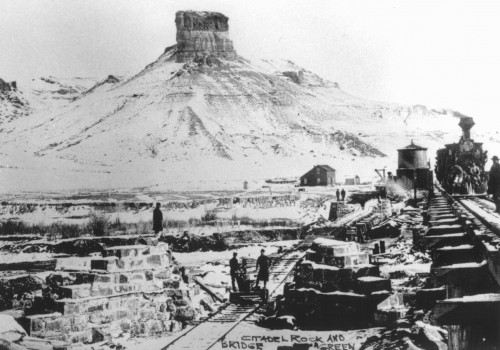
Work progresses on the Union Pacific Railroad’s bridge in Green River, Wyoming near the Green River Butte, now better known as Castle Rock.
The city of Green River takes its name from the river, which flows through the center of town, and its identity from the impressive rock formations that tower above it.
Learn more about the building of the Transcontinental Railroad.
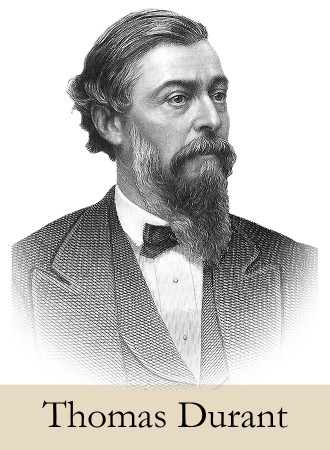
Thomas Clark “Doc” Durant was an American financier, as well as vice-president and general manager of the Union Pacific Railroad. In the 1860s, he negotiated a contract to oversee the construction of the Union Pacific’s juncture with the Central Pacific as part of America’s Transcontinental Railroad. In this role, Durant extended his interests to benefit from the railroad’s construction. He created the financial structure that led to the Credit Mobilier of America. This venture erupted into scandal after Durant persuaded several politicians and prominent merchants to invest as limited stockholders. All the while, Durant was manipulating the stock market to increase his own value in the company.
As for the actual construction of the railroad, the government paid for each mile of track laid. Durant overrode his engineers and ordered extra track to be laid in large U-shaped meanderings (oxbows). Due to these time-wasting tactics, the railroad had only progressed forty miles west of Omaha, Nebraska after two and a half years of construction. Despite this, Durant was able to avoid any federal oversight because the United States was preoccupied with the Civil War.
Meanwhile, “war” was raging within the ranks of the Union Pacific construction crew over Duran’t poor management. This led to a major disagreement between Durant and General Grenville Dodge, which resulted in “The Meeting” at Fort Sanders.
Learn more about Thomas Durant and the building of the First Transcontinental Railroad.
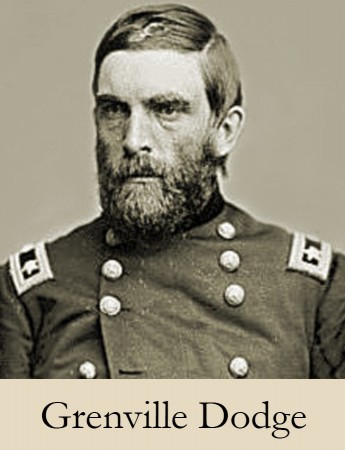
General Grenville M. Dodge was the chief engineer and a driving force behind the construction of the Union Pacific Railroad.
A veteran of the Civil War, Major General Dodge was hired by financier Thomas Durant and was indispensable in this role. However, the project suffered due to Durant’s constant meddling and efforts to milk the construction process for his own personal profit. Dodge’s conflicts with Durant became well-known, yet he persisted in his mission to build a straight run of railroad track through Wyoming.
In 1866, General Dodge was elected to Congress in Iowa. He was criticized for neglecting his official duties in order to survey Wyoming Territory for the railroad, yet he spent much of his time on Capitol Hill lobbying on behalf of the Union Pacific.
Learn more about Grenville Dodge and the building of the Transcontinental Railroad.
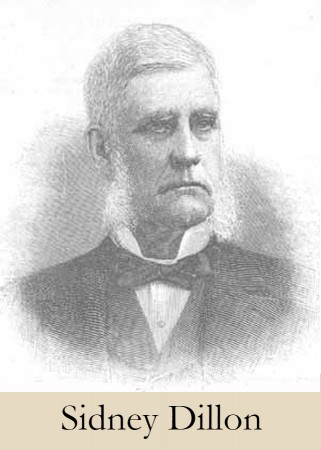
Sidney Dillon was one of America’s premier railroad builders and was involved in the construction of many railroads. His largest contract was made with the Union Pacific Railroad in 1865.
Dillon’s experience in the construction of railroads made him an invaluable member of the Union Pacific construction team. However, in 1865 he also became actively involved in an equity exchange with the Crédit Mobilier of America Corporation, created by Thomas C. Durant, vice president and general manager of Union Pacific. This scheme was set up to defraud taxpayers during the construction of the Transcontinental Railroad.
In spite of the ensuing scandal, Dillon served as President of the Union Pacific Railroad from 1874 – 1979, and again from 1890 – 1892.
Learn more about Sidney Dillon and the building of the Transcontinental Railroad.
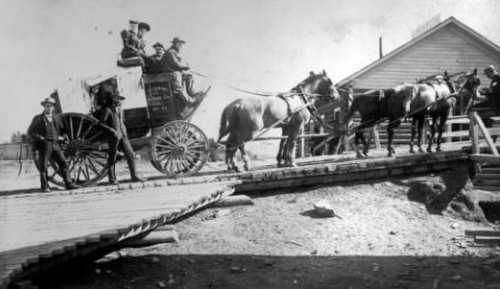
The Overland Trail was a stagecoach and wagon trail used as an alternative route to the Oregon, California, and Mormon trails through central Wyoming in the 1860s. The Overland Stage Company, owned by Ben Holladay, used the trail to run both mail and passengers to Salt Lake City.
With the onset of the Civil War, soldiers previously assigned to guard stage station property were unavailable to protect the trail against stock theft and harassment of passenger coaches. Holladay requested permission of the federal government for protection to move the stage line route further south into what is now southern Wyoming.
Col. William A. Collins, Army commander of the region, had few troops to spare other than the “galvanized Yankees” – former Confederate soldiers who had chosen to serve on the frontier as an alternative to prisoner-of-war camp – but his unit assisted successfully with moving the company’s equipment and personnel to a new route.
Eventually, Fort Collins, in Colorado, would be named for Col. Collins.
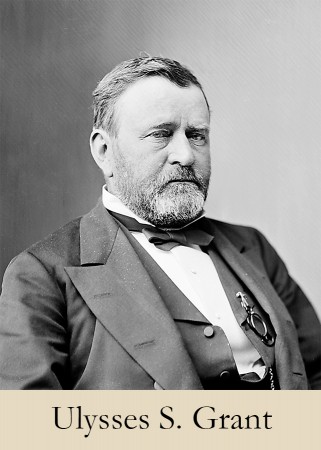
Ulysses S. Grant was a United States General and commander of the Union armies during the latter years of the Civil War. Serving under President Abraham Lincoln, he engineered a successful end to the Civil War in 1865.
In 1868, when a major dispute arose between Dr. Thomas Durant and General Dodge over the engineering of the Union Pacific Railroad, General Grant was called in as a mediator. He made it clear in the meeting that General Dodge was expected to be the chief engineer on the project.
Grant became the 18th president of the United States (1869–77).
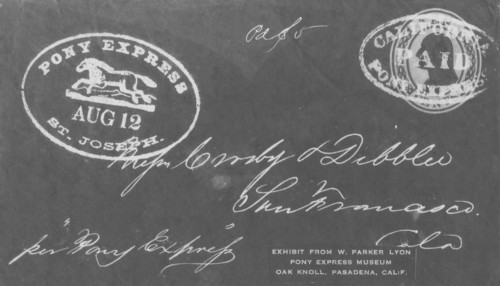
The Pony Express was a mail delivery service by horseback that used a series of relay stations operating from April 1860 to October 1861. The route began in St. Joseph, Missouri and traveled across the Great Plains, over the Rocky Mountains, running as far the Sierra Nevada and Sacramento, California. Founders William H. Russell, Alexander Majors, and William B. Waddell were all notable in the freighting business.
The Pony Express became the West’s most direct means of east–west communication before the telegraph was established, and was vital for tying the new state of California with the rest of the United States.